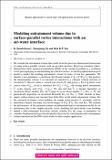| dc.contributor.author | Hendrickson, Kelli | |
| dc.contributor.author | Yu, Xiangming | |
| dc.contributor.author | Yue, Dick K.P. | |
| dc.date.accessioned | 2024-07-22T20:40:05Z | |
| dc.date.available | 2024-07-22T20:40:05Z | |
| dc.date.issued | 2022-03-14 | |
| dc.identifier.issn | 0022-1120 | |
| dc.identifier.issn | 1469-7645 | |
| dc.identifier.uri | https://hdl.handle.net/1721.1/155740 | |
| dc.description.abstract | We consider the entrainment volume that results from the quasi two-dimensional interactions
of rising surface-parallel vorticity with an air-water interface. Based on systematic (three10
dimensional) direct numerical simulations (DNS) of the canonical problem of a rectilinear
vortex pair impinging on and entraining air at the free surface,we develop a phenomenological
model to predict the resulting entrainment volume in terms of four key parameters. We
identify a new parameter, a circulation flux Froude number 𝐹𝑟2Ξ
= |Γ|𝑊/𝑎2𝑔, that predicts the dimensionless volume ∀ of entrained air initiated by a coherent vortical structure of
circulation Γ, effective radius 𝑎, vertical rise velocity𝑊 with gravity 𝑔. For 𝐹𝑟2Ξ
below some
critical value 𝐹𝑟2Ξ
𝑐𝑟 , no air is entrained. For 𝐹𝑟2Ξ
> 𝐹𝑟2Ξ
𝑐𝑟 , the average initial entrainment
∀𝑜 scales linearly with (𝐹𝑟2Ξ
− 𝐹𝑟2Ξ
𝑐𝑟 ). We also find that ∀𝑜 is linearly dependent on
circulation Weber number 𝑊𝑒Γ for a range of vortex Bond number 5 ≲ 𝐵𝑜Γ ≲ 50, and
parabolically dependent on circulation Reynolds 𝑅𝑒Γ for 𝑅𝑒Γ ≲ 2580. Outside of these
ranges, surface tension and viscosity have little effect on the initial entrainment volume. For
the canonical rectilinear vortex problem, the simple model predicts ∀𝑜 extremely well for
individual coherent structures over broad ranges of 𝐹𝑟2Ξ, 𝑊𝑒Γ, 𝐵𝑜Γ and 𝑅𝑒Γ. We evaluate
the performance of this parameterization and phenomenological entrainment model for air
entrainment due to the complex periodic vortex shedding and quasi-steady wave breaking
behind a fully-submerged horizontal circular cylinder. For the range of parameters we
consider, the phenomenologicalmodel predicts the event-by-event dimensionless entrainment
volume measured in the DNS satisfactorily for this complex application. | en_US |
| dc.language.iso | en_US | |
| dc.publisher | Cambridge University Press | en_US |
| dc.relation.isversionof | 10.1017/jfm.2022.144 | en_US |
| dc.rights | Creative Commons Attribution-NonCommercial-NoDerivs License | en_US |
| dc.rights | Attribution-NonCommercial-ShareAlike 4.0 International | * |
| dc.rights.uri | http://creativecommons.org/licenses/by-nc-sa/4.0/ | en_US |
| dc.source | Author | en_US |
| dc.title | Modelling entrainment volume due to surface-parallel vortex interactions with an air–water interface | en_US |
| dc.type | Article | en_US |
| dc.identifier.citation | Hendrickson K, Yu X, Yue DKP. Modelling entrainment volume due to surface-parallel vortex interactions with an air–water interface. Journal of Fluid Mechanics. 2022;938:A12. | en_US |
| dc.contributor.department | Massachusetts Institute of Technology. Department of Mechanical Engineering | |
| dc.relation.journal | Journal of Fluid Mechanics | en_US |
| dc.eprint.version | Author's final manuscript | en_US |
| dc.type.uri | http://purl.org/eprint/type/JournalArticle | en_US |
| eprint.status | http://purl.org/eprint/status/PeerReviewed | en_US |
| dspace.date.submission | 2024-07-22T20:30:52Z | |
| mit.journal.volume | 938 | en_US |
| mit.license | OPEN_ACCESS_POLICY | |
| mit.metadata.status | Authority Work and Publication Information Needed | en_US |
